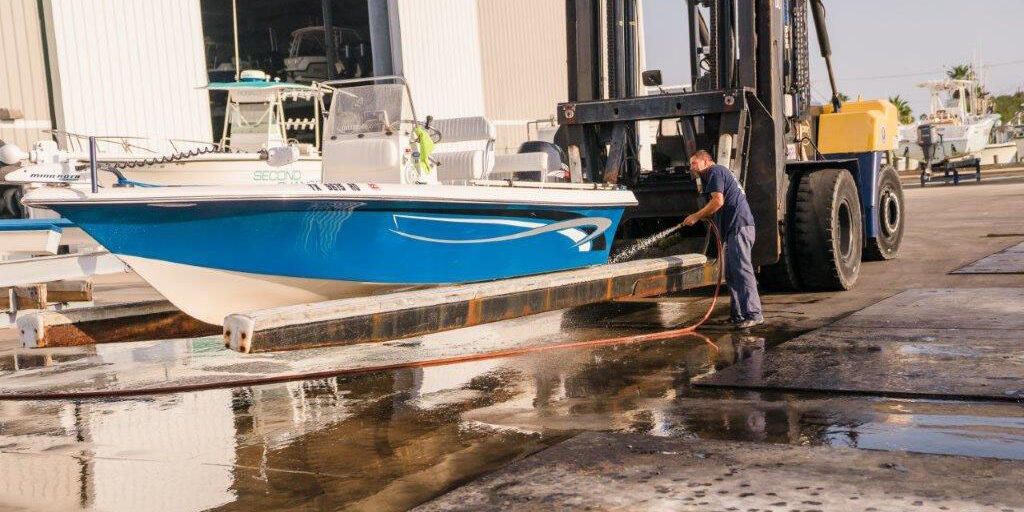HOW TO MAINTAIN YOUR BOAT DURING OFF-SEASON
Unfortunately, the boating season is coming to an end. That means it’s time to winterize your boat!
Proper maintenance during the colder months is absolutely crucial to ensure that your boat remains in excellent condition. Through properly preparing your boat for the winter, you can make sure your boat is ready to hit the water when the season returns. In this guide, we’ll discuss essential maintenance tips, covering everything from cleaning, storing, and properly winterizing your boat.
When is Off-Season?
Because Texas tends to have mild winters, the off-season in Galveston typically spans from late fall to early spring. While some boaters might still enjoy occasional outings, it’s essential to treat this period as a time for maintenance and preparation if you plan on staying off the water during the colder months.
Neglecting your boat during the off-season can lead to costly repairs, reduced performance, and a shorter lifespan for your vessel. If you want your boat to be ready and in tip-top shape once boating season comes back around in spring, it’s important to properly prepare your boat for the colder months.
Note that fully winterizing your boat requires a decent time commitment. However, taking the proper amount of time to make sure your boat is ready for the off-season ensures that your boat will be ready to hit the water with no problems once the sun starts shining again!
Essential Off-Season Maintenance Tasks
These are the tasks that you absolutely should not skip if you want to keep your boat in good condition for months of disuse.
1. Cleaning and Detailing
Before diving into technical maintenance tasks, start with a thorough cleaning of your boat. Follow this checklist to ensure a deep, thorough cleaning of your boat:
- Wash the hull: Use a marine-grade soap to remove dirt, algae, and salt residue. Pay special attention to the waterline.
- Wax the exterior: Apply a good quality wax to protect the gel coat and add a protective barrier against UV rays and environmental factors.
- Clean the interior: Vacuum carpets, wipe down surfaces, and clean out the fridge. This prevents mold and mildew from developing during storage.
- Clean the windows: Use a non-abrasive cleaner on glass and acrylic surfaces to ensure clear visibility when you’re ready to head out again.
2. Engine Maintenance
Your engine is the heart of your boat, and keeping it in top shape is vital. Having to replace your boat’s engine not only will cost you a significant amount, but it takes away valuable days that could be spent on the water instead.
To keep your engine in good shape for as long as possible, follow these steps:
- Change the oil: Replace the oil and oil filter to remove contaminants and ensure smooth operation when the season begins.
- Check belts and hoses: Inspect for cracks or wear and replace as needed.
- Battery maintenance: Disconnect the battery and clean the terminals. If you have a lead-acid battery, check the fluid levels and top off with distilled water if necessary.
- Cooling system: Flush the engine cooling system to remove any buildup and add fresh antifreeze, especially if temperatures might drop.
3. Fuel System Care
Proper fuel system maintenance can prevent issues in the upcoming season. Clean fuel lines and filters allow for proper fuel flow, which helps the engine run smoothly and efficiently. Neglecting the fuel system can lead to reduced power and responsiveness.
- Fuel stabilizer: Add a fuel stabilizer to your tank to prevent the fuel from degrading and causing issues.
- Fill the tank: Keeping your tank full minimizes condensation and helps prevent corrosion. Plus, once you’re ready to hit the water again, you should be able to just turn your boat on and get going without issues!
- Inspect fuel lines: Check for leaks or wear and replace any damaged components.
4. Electrical System Check
Ensure all electrical systems are functioning properly. Not only does this make sure your boat retains its full functionality and value, but it also helps you avoid potential safety hazards, such as driving around at night or even electrocution, that are posed by faulty wiring.
- Inspect wiring: Look for frayed or damaged wiring, especially around the battery and engine.
- Test all lights: Check navigation, cabin, and anchor lights to ensure they work.
- Replace fuses: If you find any blown fuses, replace them with the correct type and rating.
5. Plumbing and Freshwater System
Maintaining your boat’s plumbing is crucial, especially in a coastal environment. While some marinas sit on a lake, Galveston Yacht Marina provides access to the Gulf of America and Galveston Bay, both of which are saltwater bodies of water. The salt in the water can case extra corrosion of metal components in the plumbing system. Regular maintenance helps identify and address potential issues before they escalate, ensuring that pipes, fittings, and pumps remain in good condition.
- Inspect hoses: Check for leaks or cracks in hoses and replace them if necessary.
- Water pump maintenance: Clean and inspect your freshwater pump to ensure it’s ready for use.
- Winterize the system: If you expect freezing temperatures, flush the system and add non-toxic antifreeze to prevent damage.
6. Hull Maintenance
A boat’s hull provides most of its structural integrity; therefore, it is essential to take care of your hull for performance and longevity.
- Inspect for damage: Look for cracks, blisters, or signs of wear. Address any issues before storage.
- Apply anti-foulding paint: Anti-fouling paint is a specific type of paint that prevents mold, algae, and other invasive organisms from growing on your hull. If needed, apply anti-fouling paint to prevent growth during the off-season.
7. Sail and Rigging Care
If you don’t own a sailboat, you can skip this step! For sailboats, though, proper care of sails and rigging is essential for navigation and steering when you’re ready to take your boat back out on the water in the spring or summer.
- Inspect sails: Check for tears or wear and repair as needed. Clean and store sails in a dry place.
- Inspect rigging: Inspect all lines and halyards for wear and replace as necessary.
Storage Options
Indoor vs. Outdoor Storage
When it comes to boat storage, there are two main options: dry storage and wet storage.
Dry storage involves keeping the boat out of the water, typically on land or in a covered facility. Boats are often placed on racks, trailers, or in dedicated storage units for dry storage. This type of storage is great because it keeps your boat protected from the elements, which prevents rusting and algae/bacteria growth.
Wet storage requires you to keep your boat outside and in the water, usually in a boat slip and under a covered awning. While this is a more affordable options, it requires extra precautions, such as using covers and ensuring proper ventilation, to keep your boat safe. Additionally, you run the risk of damaging your boat due to exposure to the elements.
During the summer and spring, when you’re using your boat frequently, wet storage makes more sense because of how accessible your boat is and how little maintenance it probably needs. However, for the sake of winterizing your boat, we definitely recommend dry storage.
Choosing the Right Storage Facility
When selecting a storage facility, there are a few different things for you to consider.
First, how accessible is your boat? The list of winterization tasks is fairly long, so you’ll probably get your boat ready for the off-season over the course of a few days. For that reason, you’ll want to be able to reach it without hassle.
Second, what security measures are in place at your storage facility? If a storage facility has little or no security measures in order to protect your boat, you run the risk of dealing with damage to your boat or even theft. Make sure to store your boat in a location where you know it’ll be safe throughout the off-season.
Third, how reputable is your location? Word of mouth is the most powerful form of marketing, so what are most people saying about the storage facility you have in mind? Read reviews and ask fellow boat owners where they store their boats during the off-season to give you a good starting point in your search.
If you are local to the Galveston area, Galveston Yacht Marina offers dry stack and wet slip storage options. Not only are our storage facilities secure with gated access, but we also have done everything we can to make your experience with us efficient and comfortable. We have a concierge service/reservation system in our dry stack storage, a restaurant and bait store at the marina, and clean bathrooms. Reserve your spot today – they will fill up fast!
Keep Your Boat In Shape!
While Galveston experiences milder winters, winterizing your boat is still a good practice. During the winter, your boat can still become damaged due to fluctuating temperatures, humidity, pest infestations, and more. Plus, winterizing your boat means that it will run smoothly as soon as you’re ready to get back on the water in the spring or summer!
If you’re looking for somewhere to store your boat this winter, contact Galveston Yacht Marina, Galveston’s premiere marina on the Gulf of America and Galveston Bay! We offer dry stack and wet slip storage options, so you can request a quote today for whichever fits your needs.
By following these maintenance tips, you’ll not only protect your investment but also enhance your overall boating experience. Remember, a little preparation now will lead to many enjoyable days on the water when the season returns. Happy boating!


